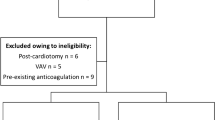Abstract
A circuit clot is one of the most frequent complications during extracorporeal membrane oxygenation (ECMO) support. We identify coagulation/fibrinolysis markers for predicting ECMO circuit exchange because of circuit clots during ECMO support. Ten patients with acute pulmonary failure who underwent veno-venous ECMO were enrolled between January 2014 and December 2016. ECMO support lasted 106 days. The 6 days on which the ECMO circuits were exchanged were considered as circuit clot (+) group, while the remaining 100 days were considered as circuit clot (−) group. The predictors of ECMO circuit exchange because of circuit clots were identified. The mean duration of ECMO support was 10 ± 13 days, and the mean number of ECMO circuit exchange was 0.6 ± 1.1 times per patient. Thrombin-antithrombin complex (TAT) and soluble fibrin (SF) were higher in the circuit clot (+) group than in the circuit clot (−) group (both P < 0.01). According to a multivariate analysis, SF was the only independent predictor of ECMO circuit exchange (P < 0.01). The odds ratio (confidence intervals) for SF (10 µg/ml) was 1.20 (1.06–1.36). The area under the curve and optimal cut-off value were 0.95 and 101 ng/ml for SF (sensitivity, 100%; specificity, 89%). SF may be useful in predicting ECMO circuit exchange because of circuit clots.



Similar content being viewed by others
References
Peek GJ, Mugford M, Tiruvoipati R, et al. Efficacy and economic assessment of conventional ventilator support versus extracorporeal membrane oxygenation for severe adult respiratory failure (CESAR): a multicenter randomized controlled trial. Lancet. 2009;374:1351–63.
Brogan TV, Thiaharajan RR, Rycus PT, Bartlett RH, Bratton SL. Extracorporeal membrane oxygenation in adults with severe respiratory failure: a multi-center database. Intensive Care Med. 2009;35:2105–14.
Kolla S, Awad SS, Rich PB, et al. Extracorporeal life support for 100 adult patients with severe respiratory failure. Ann Surg. 1997;226:565–6.
Vogler EA, Siedlecki CA. Contact activation of blood-plasma coagulation. Biomaterials. 2009;30:1857–69.
Urlesberger B, Zobel G, Zenz W, et al. Activation of the clotting system during extracorporeal membrane oxygenation in term newborn infants. J Pediatr. 1996;129:264–8.
Webb AR, Mythen MG, Jacobson D, Mackie IJ. Maintaining blood flow in the extracorporeal circuit: haemostasis and anticoagulation. Intensive Care Med. 1995;21:84–93.
G Annich, W Lynch, G MacLaren, J Wilson, R Bartlett. ECMO extracorporeal cardiopulmonary support in critical care. 4th ed. Ann Arbor: Michigan; 2012.
Oliver WC. Anticoagulation and coagulation management for ECMO. Semin Cardiothorac Vasc Anesth. 2009;13:154–75.
Lubnow M, Philipp A, Dornia C, et al. d-dimer as an early marker for oxygenator exchange in extracorporeal membrane oxygenation. J Crit Care 2014;29:473.e1-5.
Arnold P, Jackson S, Wallis J, et al. Coagulation factor activity during neonatal extracorporeal membrane oxygenation. Intensive Care Med. 2001;27:1395–400.
Dornia C, Philipp A, Bauer S, et al. d-dimer are a predictor of clot volume inside membrane oxygenators during extracorporeal membrane oxygenation. Artif Organs. 2015;39:782–7.
Dempfle CE. The use of soluble fibrin in evaluating the acute and chronic hypercoagulable state. Thromb Haemost. 1999;82:673–83.
Tsuji A, Wada H, Matsumoto T, et al. Elevated levels of soluble fibrin in patients with venous thromboembolism. Int J Hematol. 2008;88:448–53.
Sudo A, Wada H, Nobori T, et al. Cut-off values of d-dimer and soluble fibrin for prediction of deep vein thrombosis after orthopaedic surgery. Int J Hematol. 2009;89:572–6.
Asakura H. Classifying types of disseminated intravascular coagulation: clinical and animal models. J Intensive Care. 2014;2:20.
Author information
Authors and Affiliations
Corresponding author
Ethics declarations
Conflict of interest
The authors declare that there is no conflict of interest.
Rights and permissions
About this article
Cite this article
Hoshino, K., Muranishi, K., Kawano, Y. et al. Soluble fibrin is a useful marker for predicting extracorporeal membrane oxygenation circuit exchange because of circuit clots. J Artif Organs 21, 196–200 (2018). https://doi.org/10.1007/s10047-018-1021-x
Received:
Accepted:
Published:
Issue Date:
DOI: https://doi.org/10.1007/s10047-018-1021-x




